
Augmented reality (AR) is an interactive experience that combines the real world and computer-generated 3D content. The content can span multiple sensory modalities, including visual, auditory, haptic, somatosensory and olfactory. AR can be defined as a system that incorporates three basic features: a combination of real and virtual worlds, real-time interaction, and accurate 3D registration of virtual and real objects. The overlaid sensory information can be constructive, or destructive. As such, it is one of the key technologies in the reality-virtuality continuum.

Installation art is an artistic genre of three-dimensional works that are often site-specific and designed to transform the perception of a space. Generally, the term is applied to interior spaces, whereas exterior interventions are often called public art, land art or art intervention; however, the boundaries between these terms overlap.

Digital art refers to any artistic work or practice that uses digital technology as part of the creative or presentation process. It can also refer to computational art that uses and engages with digital media. Since the 1960s, various names have been used to describe digital art, including computer art, electronic art, multimedia art, and new media art.
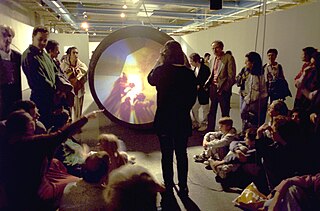
Interactive art is a form of art that involves the spectator in a way that allows the art to achieve its purpose. Some interactive art installations achieve this by letting the observer walk through, over or around them; others ask the artist or the spectators to become part of the artwork in some way.
Video game art is a form of computer art employing video games as the artistic medium. Video game art often involves the use of patched or modified video games or the repurposing of existing games or game structures, however it relies on a broader range of artistic techniques and outcomes than artistic modification and it may also include painting, sculpture, appropriation, in-game intervention and performance, sampling, etc. It may also include the creation of art games either from scratch or by modifying existing games.

Mixed reality (MR) is a term used to describe the merging of a real-world environment and a computer-generated one. Physical and virtual objects may co-exist in mixed reality environments and interact in real time.
mezangelle is a poetic-artistic language developed in the 1990s by Australian-based Internet artist Mez Breeze. It is recognized as a central contribution to Codework, Electronic literature, Internet Art and digital writing in general.
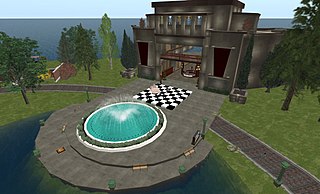
A virtual museum is a digital entity that draws on the characteristics of a museum, in order to complement, enhance, or augment the museum experience through personalization, interactivity, and richness of content. Virtual museums can perform as the digital footprint of a physical museum, or can act independently, while maintaining the authoritative status as bestowed by the International Council of Museums (ICOM) in its definition of a museum. In tandem with the ICOM mission of a physical museum, the virtual museum is also committed to public access; to both the knowledge systems embedded in the collections and the systematic, and coherent organization of their display, as well as to their long-term preservation. As with a traditional museum, a virtual museum can be designed around specific objects, or can consist of online exhibitions created from primary or secondary resources. Moreover, a virtual museum can refer to the mobile or World Wide Web offerings of traditional museums ; or can be born digital content such as, 3D environments, net art, virtual reality and digital art. Often, discussed in conjunction with other cultural institutions, a museum by definition, is essentially separate from its sister institutions such as a library or an archive. Virtual museums are usually, but not exclusively delivered electronically when they are denoted as online museums, hypermuseum, digital museum, cybermuseums or web museums.
G. H. Hovagimyan is an American experimental cross-media, new media art and performance artist who lives and works in New York City.

Virtual art is a term for the virtualization of art, made with the technical media developed at the end of the 1980s. These include human-machine interfaces such as visualization casks, stereoscopic spectacles and screens, digital painting and sculpture, generators of three-dimensional sound, data gloves, data clothes, position sensors, tactile and power feed-back systems, etc. As virtual art covers such a wide array of mediums it is a catch-all term for specific focuses within it. Much contemporary art has become, in Frank Popper's terms, virtualized.
A projection augmented model is an element sometimes employed in virtual reality systems. It consists of a physical three-dimensional model onto which a computer image is projected to create a realistic looking object. Importantly, the physical model is the same geometric shape as the object that the PA model depicts.
Furtherfield.org is an artist-led online community, arts organisation and online magazine. It creates and supports global participatory projects with networks of artists, theorists and activists. and offers "a chance for the public to present its own views and enter or alter various art discourses". Their lab-office and gallery currently operates out of in Finsbury Park in London, UK.
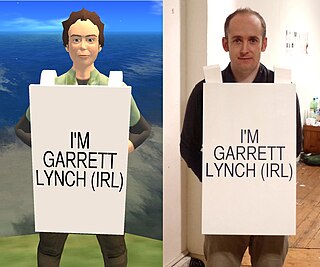
Garrett Lynch is an Irish new media artist working with networked technologies in a variety of forms including online art, installation, performance and writing.

Annie Abrahams is a Dutch performance artist specialising in video installations and internet based performances, often deriving from collective writings and collective interaction. Born and raised in Hilvarenbeek in the Netherlands, she migrated to and settled in France in 1987. Her performance work challenges and questions the limitations and possibilities of online communication and collaboration. Abrahams describes her body of work as "an aesthetics of trust and attention." Studying biology became an inspiration for her future line of work. "When studying biology I had to observe a colony of monkeys in a zoo. I found this very interesting because I learned something about human communities by watching the apes. In a certain way I watch the internet with the same appetite and interest. I consider it to be a universe where I can observe some aspects of human attitudes and behaviour without interfering."
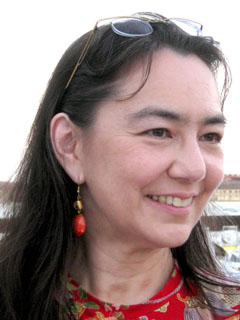
Tamiko Thiel is an American artist, known for her digital art. Her work often explores "the interplay of place, space, the body and cultural identity," and uses augmented reality (AR) as her platform. Thiel is based in Munich, Germany.
Gabriel Barcia-Colombo,, is an American video artist, filmmaker best known for his innovative video sculpture installations. He explores themes of memory, identity, and human connection through a unique combination of video, photography, and video sculpture..

Arte Laguna Prize is an international art and design competition which takes place in Venice (Italy) since 2006 and it is aimed at promoting and enhancing contemporary art. There are different contest sections: painting, sculpture and installation, photographic art, video art, performance, virtual art, digital graphics, land art, urban art and design. The competition is based in Venice, open to all, with free theme and no age restrictions. Its goal is to promote the artists and their careers through an array of opportunities.

Gretta Louw is a multi-disciplinary artist who has worked with artforms as varied as digital media and networked performance, installation and video art, and fibre art. She lives and works in Germany and Australia. Her artistic practice explores the potential of art as a means of investigating psychological phenomena, particularly in relation to new technologies and the internet. Her focus is on how new digital technologies are shaping contemporary experience.
Ruth Catlow is an English artist-theorist and curator whose practice focuses on critical investigations of digital and networked technologies and their emancipatory potential. She is also the Director, with Marc Garrett, of the Furtherfield gallery, commons space, and online arts-writing platform based out of London, which the duo founded in 1997.
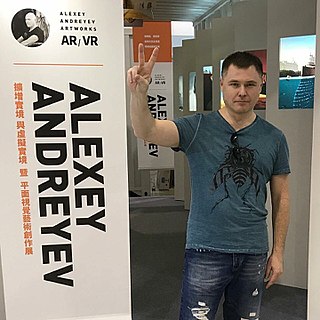
Alex Andreev is a Russian artist working in digital painting, using virtual and augmented reality in his artworks.















